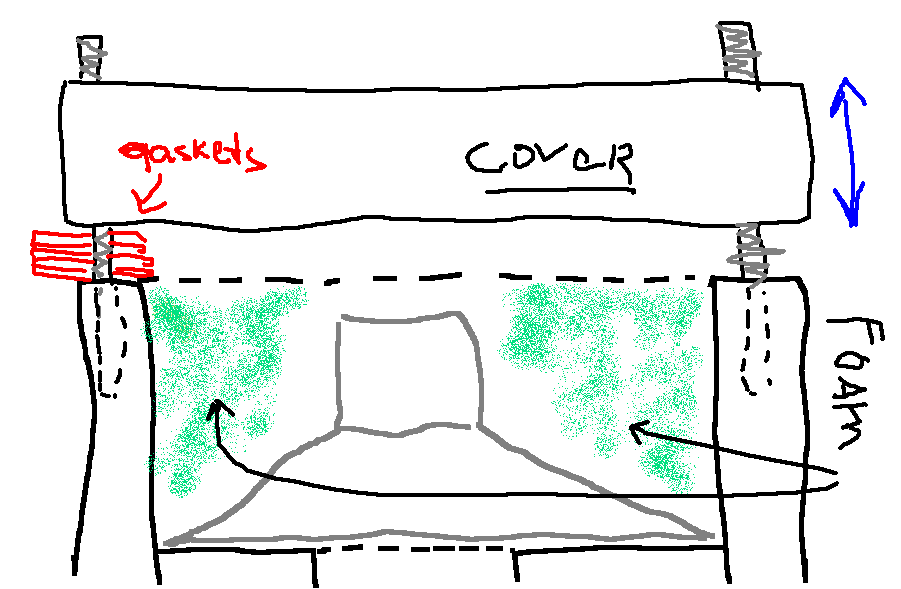|
A visitor of my site, a guy who never ask stupid question about audio, asked me a question how to find a correct size of the back chamber of a straight upper bass horn that he juts built. I wrote a reply but then realized that it would be worth to upload to my site. So, here is a “Short practical manual for tuning the back chambers”.
Theoretically you need to bring the resonance of the driver to compensate the throat reactance (in fact the throat reactance does not exist but it is another story). So you need to tune the resonance of the driver to the horn's cut off. But hear is a catch: if your horn is 90Hz for making the resonance closer to 90Hz you will HUGELEY change the sound of the horn and the last few Hz will be the most affective. It is imposable to predict how any given driver in any given horn and in any given room will perform. So, any bass horn should be tuned by ears and here is how it should be done.
You need to fill up ALL space in your back chamber, making the driver very-very over dumped. To do so, cover the back chamber and back of the driver with some kind of paper and fill all space with expending foam from a can. Then make channels in the foam form the drivers to the chamber's cover. When you seal the chamber's cover you have a driver that operates in the smallest possible chamber space (all space is filed with the hard foam, let the foam to dry out for a 2-3 days). Spend a few days listening the horn and learn to hate it - it will be very over dumped. Confirm that your resonance frequency will be way into the horn listenable range.
Then, while listing the horn ask somebody slowly unseal the cover of the back chamber and pay attention how the sound will be changed. At this point it will sound like you introduce a port a with variable hole to a bass-reflex design. However the introduction of this port will not change the amplitude of the bass (like in the bass-reflex) but only the level of dumping of the driver and the structure of bass.
Find a position of the back cover when any further opening of the back chamber do not affect sound. Measures the driver’s resonance frequency. So, now you have a resonance frequency folk between the fully over-damped driver and the driver when it dives into the “open baffle” mode. The correct setting for your driver and your horn and your room will be between the resonance frequency folk of something that I call FsMin and FsMax.
I is impossible to say what would be the correct setting – you have to listen it (at the default location) and make a decision in according to your own definition of “proper sound” and in according to your personal level of “perceptional sonic corruption”. Do not make any fast decision – for inexperienced person (and you all are inexperienced in what I describing) it might take weeks. Teach yourself to listen the upperbass horn alone as well as I context of the other channels. Pay extra attraction to the solo piano recordings. As few mm of opening of the back chamber will affect upperbass very aggressively and you will be confided in beginning. Do not use you own “I like it better” motivation to decide what is correct. Do not forger it is not abut your personal preferences but about the objective correctness. If you confused then get another recording, go to live performance or read a book about the composer/performer what you used for your test recordings. Do not forget to use some kind of guide to objectively monitor the level of the back chamber opening. Fs, is good objective measurement but it is not friendly for auditioning - you would need something more initiative. Most likely you back chamber will have many bolts/stands to seal it. Buy many thin large gaskets and tight the chamber’s bolts/nuts placing the gaskets between the chamber and cover. Changing the amount of the gaskets you will open up the chamber:

After you finally agree with the quality of bass that you get from your horn at the very specific amount of gaskets then you can measure your finale resonance frequency, let call it FsFinal. Bow you can take the cover off and remove all foam (it will be easy to do since the foam did not stick to the chamber but to the paper). Removed the driver and apply the foam (I prefer to use the lowest expansion foam) into the chamber’s sides (if you need to reduce the chamber a lot then keep the driver but protect it). When the foam solidifies cut it with knife of necessary. You goal now is to fill the back chamber with foam in order to have the chamber with the completely sealed cover to the have the FsFinal resonance frequency. If you have still little less Hz then add some foam onto the back chamber’s cavities. If you have FsFinal a little too height then cut off some foam of all some furniture-type (collapsible) foam. When you reach the FsFinal then seal the back chamber and install the horn at it’s operational default location. Listen it and confirm that the horn does exactly what you need sonically. After this, slightly open the back chamber and confirm that the sound gets worse and the dynamic slightly collapses with open chambers. Seal the back chamber again and forget about it, unless you desisted to change driver or move the horn. Rgs,
Romy the caT
"I wish I could score everything for horns." - Richard Wagner. "Our writing equipment takes part in the forming of our thoughts." - Friedrich Nietzsche
|